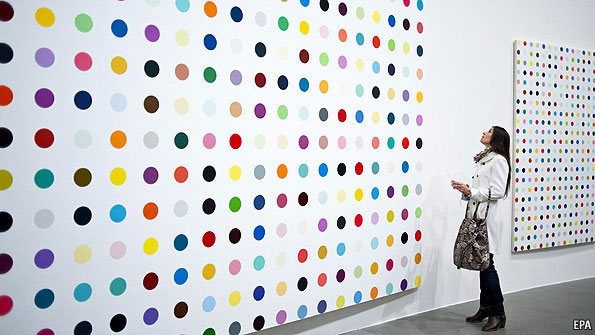Gagosian Davies Street, Free, January 12 – February 18, 2012
The significance of patternation
The dot paintings of Damien Hirst’s are on first impressions dull, uninspired and seem to be lacking strong creative engagement. Having said this one acknowledges that the work is conceptual and in turn concedes that the conceptual is not concerned with the pictorial per se. Hence the visual aspect of the end result does not precede the conclusion and/or inception of the idea and in turn nor does it need to be reciprocal of aesthetic values.
Spot the differences
As a matter of course what is a dot? A full stop, an integer separator, or simply just a dot, period. The dots in Hirst’s work are coloured which nods to, on some level an implied aesthetic reception either by intent or design, the one chink in an otherwise solid conceptual treatment. In the paradigm for these dot paintings: Colours in one spot painting may contain those found in another but each colour therein must be unique. The interval between each dot must be the same size as the dot itself.
What is the significance of colour
As far as I have been able to discern there is no obvious correlation between the colours used and the intended reception of the work. The basis for colour choice was defined by the assistants who executed the paintings. The colour has no meaning to the viewer and as a piece of information is essentially a redundant entity. The fact that human intervention of this kind has affected the strategy in some way mars the overall conceptual nature. This reduces the works to a quasi optical art strategy though not withstanding a greater conceptual nature from the out set. The systematic process falls over when we try to bring subjective human decision into the process.
Iconography
There is no accessible iconography whatsoever which I think is its greatest achievement. The work on appearance seems to owe much to conventions. But at a more formal level one would have to ascribe the circle/spot/dot as being icon-like and in this is contained a possible reading. One inference may be the icon is the circle, it has no beginning or end it is a cycle with no departure that repeats itself – have we seen the last of the dot paintings? None of the usual leitmotifs that have become so prevalent in the work of Damien Hirst are present. The butterflies have flown away, the razor blades are gone, no skulls, nope nothing dead, morribund or memento mori in sight. So what is the attraction, well really there is none, other than having witnessed the work. Really? Yes.
Background
The spot paintings began when Hirst was a student at Goldsmiths College London at around the 1980s. Each painting itself is not the work of the author Damien Hirst, but realised under his direction assistants carried out the work according to his process. They have been regularly carried out as late as 2003. This exhibition at the Gagosian was part of a global event with Hirsts dot paintings on display at all of the eleven major location of theirs throughout the world. Other artists that used spots were Yayoi Kasuma, who was recently on show at the Walking in my mind exhibition and currently at the Tate Modern.
OUTLINE
A collection of the famous Damien Hirst spot paintings.
www.gagosian.com/exhibitions/damien-hirst–january-12-2012-8/
written by: Colin Humphrey

Be the first to comment